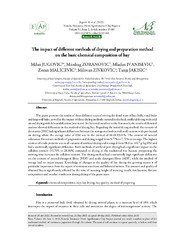Приказ основних података о документу
The impact of different methods of drying and preparation method ration method on the basic chemical composition of hay
| dc.creator | Jugovic, Milan | |
| dc.creator | Zoranovic, Miodrag | |
| dc.creator | Ivanisevic, Mladen | |
| dc.creator | Malicevic, Zoran | |
| dc.creator | Zivkovic, Milovan | |
| dc.creator | Jaksic, Tanja | |
| dc.date.accessioned | 2023-08-17T09:00:02Z | |
| dc.date.available | 2023-08-17T09:00:02Z | |
| dc.date.issued | 2023 | |
| dc.identifier.issn | 1842-4309 | |
| dc.identifier.issn | 0255-965X | |
| dc.identifier.uri | http://aspace.agrif.bg.ac.rs/handle/123456789/6405 | |
| dc.description.abstract | The paper presents the results of three different ways of storing the dried mass of hay: bulk, small bales and large roll bales, as well as the impact of three drying methods: natural in the field, artificial drying with cold air and drying with dehumidification (warm air). In the tested meadow in the first swath, the results of chemical analyses showed differences in the method of drying hay. Regarding the tested drying method, the content of dry matter (DM) had significant differences between the storage methods as well as all variants with pre-heated air drying, where the average value of DM was in the interval of 86.18-93.01%. The content of mineral substances for certain methods of preparation and drying ranged from 5.77% to 7.72% on average. The highest content of crude proteins was in all variants of artificial drying and it ranged from 98.6 to 165.7 g/kg DM and had a statistically significant difference. Both methods of artificial post-drying had a significant impact on the cellulose content (33.76% to 28.86%) compared to drying in the traditional way because postponing the mowing time increases the cellulose content. The drying method had a statistically high significant difference on the content of neutral detergent fibres (NDF) and acidic detergent fibres (ADF), while the method of storage had no major impact. Knowledge of changes in the quality of hay during the growing season is of particular importance form the aspect of ruminant nutrition and balanced rations. The amount and quality of obtained hay is significantly affected by the time of mowing, height of mowing, swath, fertilization, floristic composition and weather conditions during drying of the green mass. | sr |
| dc.language.iso | en | sr |
| dc.publisher | Academic Pres | sr |
| dc.rights | openAccess | sr |
| dc.rights.uri | https://creativecommons.org/licenses/by/4.0/ | |
| dc.source | Notulae Botanicae Horti Agrobotanici Cluj-Napoca | sr |
| dc.subject | chemical composition | sr |
| dc.subject | hay | sr |
| dc.subject | hay drying | sr |
| dc.subject | hay quality | sr |
| dc.subject | method of preparing | sr |
| dc.title | The impact of different methods of drying and preparation method ration method on the basic chemical composition of hay | sr |
| dc.type | article | sr |
| dc.rights.license | BY | sr |
| dc.citation.issue | 2 | |
| dc.citation.rank | M22~ | |
| dc.citation.volume | 51 | |
| dc.identifier.doi | 10.15835/nbha51213180 | |
| dc.identifier.fulltext | http://aspace.agrif.bg.ac.rs/bitstream/id/24735/The_impact_pub_2023.pdf | |
| dc.type.version | publishedVersion | sr |


